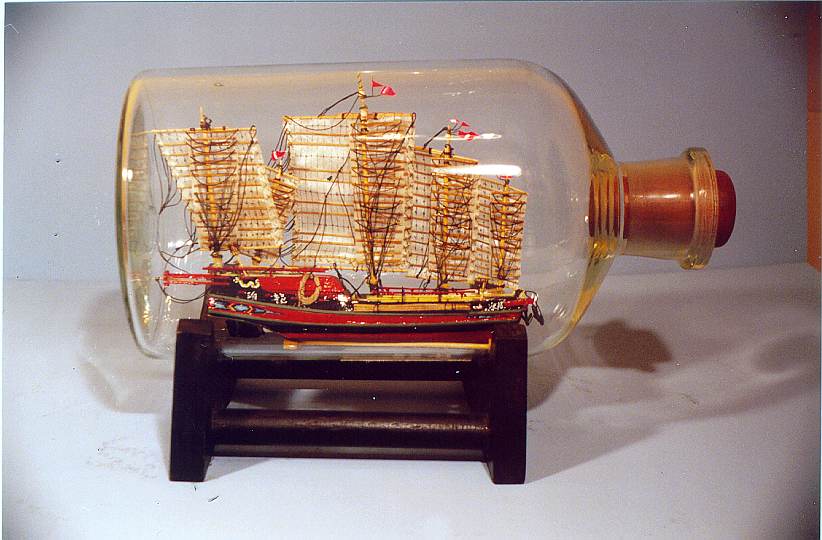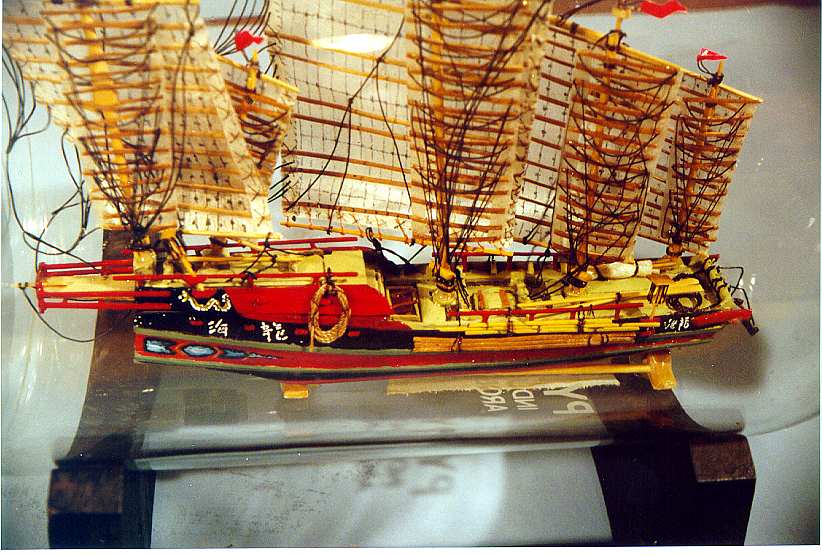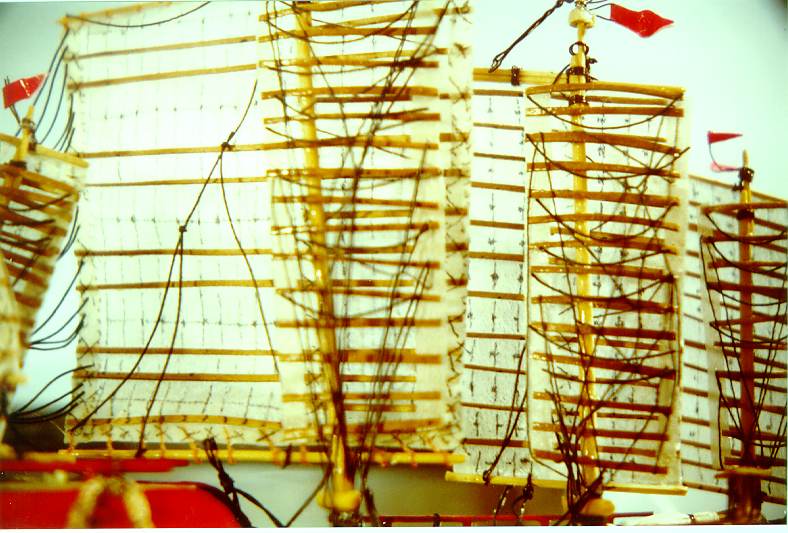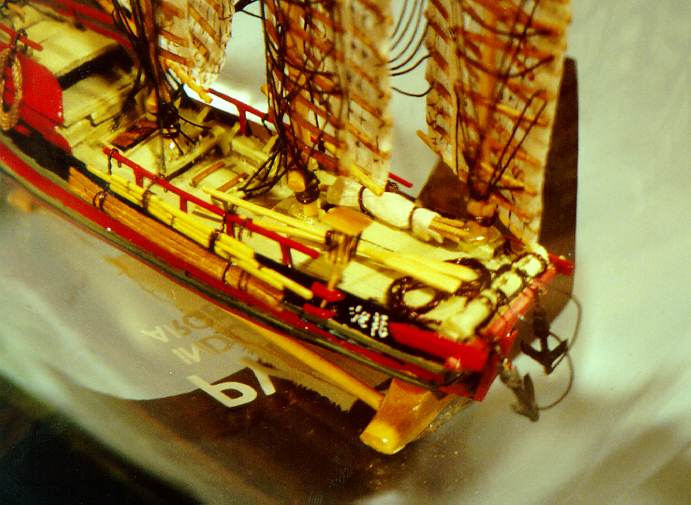
A Chinese Pechili Junk:
This article is dedicated to a master in the art, my friend in Holland, the late Peter Geerlings. His SiB models are the most outstanding I have ever seen. Thank you Peter!

The Ship:
The Pechili cargo junk had a flat pontooned hull, divided into 20 watertight bulkheads by hardwood partitions. Out of its 5 masts, the foremost, and the next aftermost mizzen could be rigged upon request. To this end, mast steps had been added to the port side, to stand out of way and also to aid in steering the vessel into the prevailing winds. The crew accomodated below the quarterdeck. A stern gallery projected aft, also served to handle the mizzen braces.
Traditionally, junks carried spare battens, sail clothes and long oars to allow handling in shallow waters or confined moorings, where their rigid sails were less efficient. The truly innovative lug sails stiffened by battens rendered it possible for the junk to sail efficiently into the wind, while the reefing was controlled by means of a clever system of martnets or clew garnets, indeed comparable to "persian blinds". Main rudder could be raised in its keel box to jump shallows. A Pechili (or Bejili) junk was a trading vessel which sailed the waters of the Gulf carrying this name, near the harbour of Tientsin, mouth of Hai He river.
This ship has been described by Mr Landstr÷m in his book The Ship. He states that at the beginning of the XXth century the largest samples exceeded 180 feet long.
During the thirties quite some could still be seen in use. I have also seen photos of a model in existence in a Seafaring Museum. The present model shows a junk of ca 1850.
The Model:
Please, prepare to board the junk. In this starboard broadside close up view, the vessel stands completely equipped, all sails set, gaining the open sea.

In this starboard broadside view , we can see the model junk. It is built inside a 2 ltr medicine bottle, at approximately 1:300 scale.
The model stands upright inside the bottle, on a wooden keel rest. No sea has been modelled. The hull had to be split into two pieces, to allow assembly through bottleneck.
Modelling junks is a specialty in its own right.The hulls, rigging and systems are completely different to the western type of ship. You will face specific challenges. Even the finished model does not look exactly like you or anyone would expect. But, once you are in, you will be caught by that haunting oriental flavor.
Lug Sail / Rigging Close up:

In this close up it is possible to get an idea of the complex rigging of a cargo seafaring junk of this time. (Please note the next after mizzen is not wrong. It was slanted on the original junk to allow combined steering with the aft mizzen).The lug sails are reinforced by means of battens. Battens are fixed to the mast by means of bamboo reinforcements and rope loops, allowing them to turn into every position , to better catch the wind. This also avoids the need of shrouds, since the force of the wind is evenly distributed along the mast. The additional ropes were intended to handle the reefing.Martnets and all standing and running rigging have been reproduced. The crowfeet on the afterleech controlled the angle, reefing was done by lowering the sail while fastening each particular sheet, by means of the already explained ropes. Mast tops have elaborated weather-vanes or flags.
Bow / Deck close up:

Bow side view. Note the two anchors and the bulky crossmenber winch hoist, a pair of oars used to maneuver in the shallows, spare sail clothes, two bundles, one of bamboo rods, the other of battens, hanging from the gunwale railing,load hatches, tackleboards and fore lantern.

Stern view of the Pechili Junk. Note the projecting gallery which served the purpose of handling the mizzen braces, and the massive rudder post and rod (note that the rudder too could be hoisted or lowered to jump the shallows). The stern has a painted phoenix, symbol of inmortality. On the quaterdeckside a golden serpent provides protection for the sailor men against the elements. The painted script means Hai Long, chinese for "Sea Dragon". We see a spare rope hanging from the gunwale. Since the models and images of the Pechili junks look rather dull and didn't provide clues on the painting and decoration, I used schemes found on Hangchow Bay and on Foochow junks.
Bibliography:
The Ship - Bj÷rn Landstr÷m. Historische Schiffsmodelle. W. zu Mondfeld, Buddelschiff Museum von Neuharlingersiel, H.Landmann, Eyewitness: Boats, Dorling Kindersley. The Visual Dictionary of Ships and Sailing,Dorling Kindersley. Oceanos.Microsoft (c). Historia de los Buques. Jean Merrien (With a very interesting commented translation by J.M¬ Hidalgo , Director of the Museo marÝtimo de Barcelona).
Bitte siehen Sie den kommentar unter "Die Buddelschiff Ecke"
Por favor, vean el comentario a este artÝculo en el rincˇn del Beb.
Return to Eddy's Thimble Pier Top page
Wish to take a look at the SIB Gallery?
(c) 2000-2020 Eduardo Raffaelli. Buenos Aires . Argentina